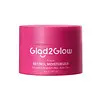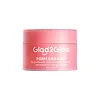What's inside
What's inside
 Key Ingredients
Key Ingredients

 Benefits
Benefits

 Concerns
Concerns

 Ingredients Side-by-side
Ingredients Side-by-side

Water
Skin ConditioningDimethicone
EmollientHydroxyethyl Urea
HumectantGlycerin
HumectantIsododecane
EmollientNiacinamide
SmoothingGlycereth-26
HumectantTrehalose
HumectantButylene Glycol
HumectantAllantoin
Skin ConditioningPhenoxyethanol
PreservativeAcrylates/C10-30 Alkyl Acrylate Crosspolymer
Emulsion StabilisingTromethamine
BufferingPolyglyceryl-6 Distearate
EmulsifyingHydrogenated Lecithin
EmulsifyingRetinol
Skin ConditioningDimethiconol
EmollientMethylparaben
PreservativePrunus Persica Fruit Extract
AbrasivePolyacrylate Crosspolymer-6
Emulsion StabilisingCarbomer
Emulsion StabilisingJojoba Esters
EmollientHexyldecanol
EmollientGlyceryl Glucoside
HumectantAmmonium Acryloyldimethyltaurate/Vp Copolymer
Ethylhexylglycerin
Skin ConditioningCetyl Alcohol
EmollientPolyglyceryl-3 Beeswax
EmulsifyingCeramide NP
Skin ConditioningPropanediol
SolventPentylene Glycol
Skin ConditioningCholesterol
EmollientAvena Sativa Kernel Extract
AbrasiveAroma
Chlorella Vulgaris Extract
Skin ConditioningLactic Acid
BufferingCentella Asiatica Flower/Leaf/Stem Extract
Skin ConditioningMatrine
AntioxidantEctoin
Skin ConditioningHydroxypinacolone Retinoate
Skin ConditioningHydroxyethylpiperazine Ethane Sulfonic Acid
BufferingAdenosine
Skin ConditioningCI 19140
Cosmetic ColorantWater, Dimethicone, Hydroxyethyl Urea, Glycerin, Isododecane, Niacinamide, Glycereth-26, Trehalose, Butylene Glycol, Allantoin, Phenoxyethanol, Acrylates/C10-30 Alkyl Acrylate Crosspolymer, Tromethamine, Polyglyceryl-6 Distearate, Hydrogenated Lecithin, Retinol, Dimethiconol, Methylparaben, Prunus Persica Fruit Extract, Polyacrylate Crosspolymer-6, Carbomer, Jojoba Esters, Hexyldecanol, Glyceryl Glucoside, Ammonium Acryloyldimethyltaurate/Vp Copolymer, Ethylhexylglycerin, Cetyl Alcohol, Polyglyceryl-3 Beeswax, Ceramide NP, Propanediol, Pentylene Glycol, Cholesterol, Avena Sativa Kernel Extract, Aroma, Chlorella Vulgaris Extract, Lactic Acid, Centella Asiatica Flower/Leaf/Stem Extract, Matrine, Ectoin, Hydroxypinacolone Retinoate, Hydroxyethylpiperazine Ethane Sulfonic Acid, Adenosine, CI 19140
Water
Skin ConditioningGlycerin
HumectantNiacinamide
SmoothingButylene Glycol
HumectantCaprylic/Capric Triglyceride
MaskingPunica Granatum Fruit Extract
AntioxidantPropylene Glycol
HumectantAmmonium Acryloyldimethyltaurate/Vp Copolymer
Dimethicone
EmollientBetaine
HumectantGlycereth-26
HumectantIsopropyl Palmitate
Emollient1,2-Hexanediol
Skin ConditioningHydroxyacetophenone
AntioxidantCetearyl Alcohol
EmollientPolyacrylate-13
Allantoin
Skin ConditioningButyrospermum Parkii Butter
Skin ConditioningCentella Asiatica Extract
CleansingDimethyl Isosorbide
SolventPolyisobutene
Parfum
MaskingSodium Hyaluronate
HumectantXanthan Gum
EmulsifyingHydroxypinacolone Retinoate
Skin ConditioningPentylene Glycol
Skin ConditioningPolysorbate 20
EmulsifyingSorbitan Isostearate
EmulsifyingRosa Hybrid Flower Extract
Skin ConditioningNonapeptide-1
Skin ConditioningTetrapeptide-1
Skin ConditioningGardenia Florida Fruit Extract
Skin ConditioningCI 16185
Cosmetic ColorantWater, Glycerin, Niacinamide, Butylene Glycol, Caprylic/Capric Triglyceride, Punica Granatum Fruit Extract, Propylene Glycol, Ammonium Acryloyldimethyltaurate/Vp Copolymer, Dimethicone, Betaine, Glycereth-26, Isopropyl Palmitate, 1,2-Hexanediol, Hydroxyacetophenone, Cetearyl Alcohol, Polyacrylate-13, Allantoin, Butyrospermum Parkii Butter, Centella Asiatica Extract, Dimethyl Isosorbide, Polyisobutene, Parfum, Sodium Hyaluronate, Xanthan Gum, Hydroxypinacolone Retinoate, Pentylene Glycol, Polysorbate 20, Sorbitan Isostearate, Rosa Hybrid Flower Extract, Nonapeptide-1, Tetrapeptide-1, Gardenia Florida Fruit Extract, CI 16185
 Reviews
Reviews

Ingredients Explained
These ingredients are found in both products.
Ingredients higher up in an ingredient list are typically present in a larger amount.
Allantoin is a soothing ingredient known for its protective and moisturizingg properties. Because of this, it is often added to products with strong active ingredients.
Studies show higher concentrations of this ingredient can promote wound healing.
Though it can be derived from the comfrey plant, allantoin is produced synthetically for cosmetic products to ensure purity.
Learn more about AllantoinAmmonium Acryloyldimethyltaurate/Vp Copolymer (let's call it AAVC for short) is a synthetically created polymer. It's used as a film-forming agent and used to thicken the consistency of products.
AAVC is able to increase the consistency and viscosity of products due to its large molecule size. It also prevents ingredients from separating.
Butylene Glycol (or BG) is used within cosmetic products for a few different reasons:
Overall, Butylene Glycol is a safe and well-rounded ingredient that works well with other ingredients.
Though this ingredient works well with most skin types, some people with sensitive skin may experience a reaction such as allergic rashes, closed comedones, or itchiness.
Learn more about Butylene GlycolDimethicone is a type of synthetic silicone created from natural materials such as quartz.
What it does:
Dimethicone comes in different viscosities:
Depending on the viscosity, dimethicone has different properties.
Ingredients lists don't always show which type is used, so we recommend reaching out to the brand if you have questions about the viscosity.
This ingredient is unlikely to cause irritation because it does not get absorbed into skin. However, people with silicone allergies should be careful about using this ingredient.
Note: Dimethicone may contribute to pilling. This is because it is not oil or water soluble, so pilling may occur when layered with products. When mixed with heavy oils in a formula, the outcome is also quite greasy.
Learn more about DimethiconeGlycereth-26 is a synthetic ingredient and polyethylene glycol ether of Glycerin. Glycerin is already naturally found in your skin and helps keep your skin moisturized.
It is a humectant and helps add texture to products. It can make your product thicker.
As a humectant, it helps draw moisture from the air to your skin. This helps your skin stay hydrated.
Learn more about Glycereth-26Glycerin is already naturally found in your skin. It helps moisturize and protect your skin.
A study from 2016 found glycerin to be more effective as a humectant than AHAs and hyaluronic acid.
As a humectant, it helps the skin stay hydrated by pulling moisture to your skin. The low molecular weight of glycerin allows it to pull moisture into the deeper layers of your skin.
Hydrated skin improves your skin barrier; Your skin barrier helps protect against irritants and bacteria.
Glycerin has also been found to have antimicrobial and antiviral properties. Due to these properties, glycerin is often used in wound and burn treatments.
In cosmetics, glycerin is usually derived from plants such as soybean or palm. However, it can also be sourced from animals, such as tallow or animal fat.
This ingredient is organic, colorless, odorless, and non-toxic.
Glycerin is the name for this ingredient in American English. British English uses Glycerol/Glycerine.
Learn more about GlycerinThis ingredient is a retinoid. It usually goes by a more common name: "Granactive".
Hydroxypinacolone Retinoate (HPR) belongs to the class of retinoids that also includes retinol and tretinoin.
Retinoids have been proven to:
So what is the difference between all the retinoids?
Most retinoids need to go through a conversion line to become effective on skin. The ending product is retinoic acid. Retinoic acid is AKA tretinoin.
HPR is an ester of tretinoin. Emerging studies suggest HPR to have an added benefit that other retinoids don't have: Low irritation.
A study from 2021 found HPR to have the greatest stability when exposed to light and temperature out of all the commercial retinoids.
A note about naming:
The name "Granactive" is the trade name and the name most commonly used on packages.
Granactive is the name of the mixture - about 90% solvent and 10% HPR. A product with 5% granactive has 0.5% HPR.
Learn more about Hydroxypinacolone RetinoateNiacinamide is a multitasking form of vitamin B3 that strengthens the skin barrier, reduces pores and dark spots, regulates oil, and improves signs of aging.
And the best part? It's gentle and well-tolerated by most skin types, including sensitive and reactive skin.
You might have heard of "niacin flush", or the reddening of skin that causes itchiness. Niacinamide has not been found to cause this.
In very rare cases, some individuals may not be able to tolerate niacinamide at all or experience an allergic reaction to it.
If you are experiencing flaking, irritation, and dryness with this ingredient, be sure to double check all your products as this ingredient can be found in all categories of skincare.
When incorporating niacinamide into your routine, look out for concentration amounts. Typically, 5% niacinamide provides benefits such as fading dark spots. However, if you have sensitive skin, it is better to begin with a smaller concentration.
When you apply niacinamide to your skin, your body converts it into nicotinamide adenine dinucleotide (NAD). NAD is an essential coenzyme that is already found in your cells as "fuel" and powers countless biological processes.
In your skin, NAD helps repair cell damage, produce new healthy cells, support collagen production, strengthen the skin barrier, and fight environmental stressors (like UV and pollution).
Our natural NAD levels start to decline with age, leading to slower skin repair, visible aging, and a weaker skin barrier. By providing your skin niacinamide, you're recharging your skin's NAD levels. This leads to stronger, healthier, and younger looking skin.
Another name for vitamin B3 is nicotinamide. This vitamin is water-soluble and our bodies don't store it. We obtain Vitamin B3 from either food or skincare. Meat, fish, wheat, yeast, and leafy greens contain vitamin B3.
The type of niacinamide used in skincare is synthetically created.
Learn more about NiacinamidePentylene glycol is typically used within a product to thicken it. It also adds a smooth, soft, and moisturizing feel to the product. It is naturally found in plants such as sugar beets.
The hydrophilic trait of Pentylene Glycol makes it a humectant. As a humectant, Pentylene Glycol helps draw moisture from the air to your skin. This can help keep your skin hydrated.
This property also makes Pentylene Glycol a great texture enhancer. It can also help thicken or stabilize a product.
Pentylene Glycol also acts as a mild preservative and helps to keep a product microbe-free.
Some people may experience mild eye and skin irritation from Pentylene Glycol. We always recommend speaking with a professional about using this ingredient in your routine.
Pentylene Glycol has a low molecular weight and is part of the 1,2-glycol family.
Learn more about Pentylene GlycolWater. It's the most common cosmetic ingredient of all. You'll usually see it at the top of ingredient lists, meaning that it makes up the largest part of the product.
So why is it so popular? Water most often acts as a solvent - this means that it helps dissolve other ingredients into the formulation.
You'll also recognize water as that liquid we all need to stay alive. If you see this, drink a glass of water. Stay hydrated!
Learn more about Water